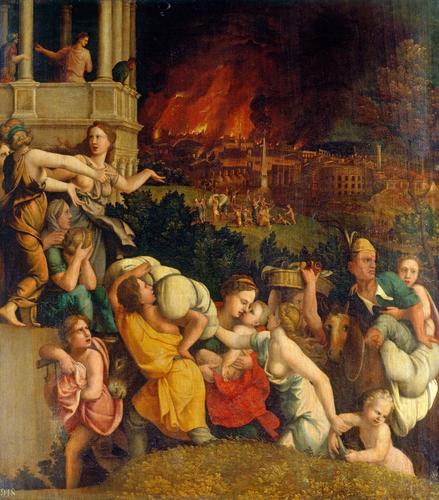-
1 of 253523 objects
Nero Playing while Rome Burns c. 1536-9
Oil on panel | 121.5 x 106.7 x 2.0 cm (support, canvas/panel/stretcher external) | RCIN 402576
-
This is one of five panels in the Royal Collection by Giulio Romano that originally belonged an elaborate decorative scheme for the state apartments within the Palazzo Ducale, Mantua. This panel comes from one of the grandest rooms, the Camerino dei Cesari (Cabinet of the Caesars), the decoration of which consisted principally of eleven powerful canvases of the Roman Emperors by Titian. The subject matter is drawn from Suetonius’s Lives of the Caesars, and reflects Federico Gonzaga’s obsession with imperial themes. Completed in 1540, Titian’s images were sadly destroyed by fire in Spain in 1734.
Giuilo played a subsidiary role in the decoration of the room; responsible for the broader ensemble into which Titian’s ‘portraits’ were fitted, he provided scenes from the life of each Emperor, to be placed below the portraits (of the original eleven only four have survived, three are in the Royal Collection). Flanking these scenes were mounted figures by Giulio representing the Emperors, and one female figure with a horse representing Victory (there were probably originally twelve of these figures, of which nine survive, two are in the Royal Collection). The ensemble of three walls (omitting the west wall) is recorded by drawings attributed to Ippolito Andreasi, c.1568 (Museum Kunst Palast, Düsseldorf), commissioned by the antiquarian Jacopo Strada. The relationship between the grand Titian figures and Giulio’s narrative scenes below has been compared to the hierarchy of an altarpiece: the predella with anecdotal scenes from the life of the saint who is depicted above, standing in majesty. Giulio’s skill lay in the illusionistic ensemble, bringing together architecture, painting and sculpture, designed to complement Titian’s work.
Nero playing while Rome Burns originally hung beneath Titian’s painting of ‘Nero’ in the centre of the south wall. Suetonius (in The Twelve Caesars, VI, 38) describes the episode:
’Pretending to be disgusted by the drab old buildings ... [Nero] brazenly set fire to the city ... This terror lasted for six days and seven nights, causing many people to take shelter in monuments and tombs ... Nero watched the conflagration from the Tower of Maecenas, enraptured by what he called ‘the beauty of the flames’; then put on his tragedian’s costume and sang The Sack of Ilium from beginning to end.’
Nero is seated in the Septizonium, a building on the Palatine now destroyed, identified in the sixteenth century as the Tower of Maecenas. The Arch of Constantine, the Pantheon and the Colosseum are all visible in the background, though brought together in an arbitrary fashion. All the figures and the architecture of the background are painted skilfully without underdrawing (apart from the obelisk) and it is possible that Giulio contributed this part himself. He knew this part of the Roman Forum, having studied the ruins with care. There is no mention in Suetonius’s text of Nero playing a musical instrument (as opposed to just singing), but here Giulio has added a lute in place of the ancient epic poet’s instrument of choice, the lyre. Rather as Titian’s emperors were based on antique prototypes, so here Nero’s profile must have been derived from an antique coin. The refugees from the fire in the foreground derive from the scene of the Deluge from Michelangelo’s Sistine Chapel ceiling, which has the same arrangement of figures climbing upwards, cut off at the legs, carrying bundles and baskets, and seeking the apparent safety of high ground.Provenance
Acquired by Charles I from the Mantuan collection; recorded in the Long Gallery at Whitehall in 1639 (no 35); listed as reserved in the Commonwealth Sale and valued at £24 (Pictures in the Committee Rooms no 9); recovered at the Restoration and listed in the 2nd Privy Lodging Room at Whitehall in 1666 (no 173)
-
Creator(s)
Acquirer(s)
-
Medium and techniques
Oil on panel
Measurements
121.5 x 106.7 x 2.0 cm (support, canvas/panel/stretcher external)
137.7 x 121.5 x 8.5 cm (frame, external)
Category
Object type(s)
